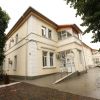Stavropoleos Monastery: 300 years of prayer in the center of the capital

By Bucharest Team
- Articles
In the center of Bucharest, hidden between the crowded streets and modern buildings, is the Stavropoleos Monastery, an Orthodox church built in the Brancovanesque style, a monument of great beauty and cultural importance.
Stavropoleos Monastery. History
Stravropoleos Monastery was built in 1724, during the second reign of Nicolae Mavrocordat (1719-1730) in Wallachia, by the Greek archimandrite Ioanichie Stratonikeas, in the courtyard of his inn. The name "Stavropoleos" comes from Greek, meaning "City of the Cross". More precisely, on October 30, 1724, the construction of the church was finalized, a fact attested by a Greek and Romanian pisany.
Many of the known inns located in the center of Bucharest had churches or monasteries in the middle of the inner courtyard; in fact, not a few of them appeared as annexes of churches and monasteries, built by the ecumenicals to increase their income. The Colțea Monastery, St. Ecaterina's Chapel, St. John's Monastery, Mihai Voda Monastery, St. Spiridon, Ghiorma Banul's Church - also called the Church of the Greeks, Sărindar Church and Zlătari Church had large inns in Bucharest. The Stavropoleos Monastery joins them, with the mention that in this case the construction of the inn preceded the erection of the church.
In 1726, Abbot Ioanichie was elected metropolitan of Stavropolis and exarch of Caria. The monastery he built has since been named Stavropoleos, after the ancient see. On February 7, 1742 the 61-year-old Ioanichie died and was buried in his church.
During the reign of the ruler Nicolae Mavrocordat, this place of worship became an important religious and cultural center, hosting numerous monastic and educational activities.
Over the years, the monastery underwent various alterations and restorations, especially in the 19th century, when the buildings surrounding the church were demolished due to decay. However, the church itself has remained standing, preserving its charm and authenticity.
It should also be noted that between 1904 and 1940, the church was a repository for architectural elements and gravestones from demolished churches in the old center of Bucharest.
Moreover, although it has known long periods of neglect, all the original elements have been preserved to the present day, making the ensemble a true academy of the spirit, a source of wisdom, tranquility, a place full of treasures, full of faith and love for people.
Stavropoleos Monastery. Church architecture and art
The place of worship, the "Ginga ctișa ctitorie", as the historian Constanti C. Giurescu calls it, located in the old center of the capital, is of unique beauty. The Stavropoleos Monastery is known for its architectural style, characterized by a combination of Byzantine, Ottoman, Renaissance and Baroque elements. The façade of the church impresses with its fine sculptural details and floral motifs, and the entrance is flanked by richly ornamented columns.
The church interior is equally impressive, with well-preserved frescoes and icons of rare beauty. The baroque iconostasis is another highlight, adorned with icons and sculptures of inestimable artistic value.
Stavropoleos Monastery. Inner courtyard and library
The inner courtyard of the monastery is a particularly peaceful and picturesque place where visitors can relax and contemplate the beauty of the place. In this courtyard there is also an ancient fountain, along with architectural remains and gravestones from various periods.
Stavropoleos Monastery Library houses an impressive collection of old books and religious manuscripts, some dating back to the 18th century. They are a valuable resource for researchers and lovers of religious history and culture.
Stavropoleos Monastery. Monastic life and cultural activities
Although the number of monks is small, monastic life at Stavropoleos Monastery is active and dedicated to prayer and spiritual work. The monastic community regularly organizes religious services, which are well attended by the faithful and tourists, and the church is packed on Sundays and major feast days.
In addition to its religious role, the monastery is also an important cultural center. Byzantine music concerts and cultural events frequently take place here, attracting a diverse audience and helping to preserve and promote the cultural and spiritual heritage of the place.
Stavropoleos Monastery is not only a place of worship of inestimable value, but also a symbol of cultural and spiritual endurance and continuity. With its architectural beauty, artistic richness and cultural activities, the monastery remains an essential landmark in the cultural landscape of Bucharest and a place of pilgrimage for believers and tourists alike. A visit to this monument offers an insight into history and a profound spiritual experience, highlighting the importance of preserving and enhancing our cultural heritage.






























